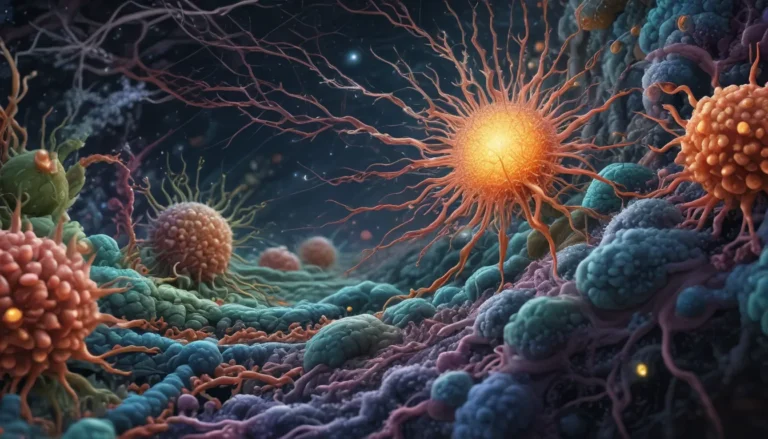A Note About Images: The images used in our articles are for illustration purposes only and may not exactly match the content. They are meant to engage readers, but the text should be relied upon for accurate information.
In the realm of biology and environmental health, endocrine disruptors have become a prevalent topic of discussion. These substances, commonly found in everyday products, have the potential to interfere with the normal functioning of the endocrine system, which regulates hormone production and secretion. The impact of endocrine disruptors extends beyond just human health, affecting wildlife populations and ecosystems as well. In this comprehensive guide, we will delve into 17 surprising facts about endocrine disruptors, shedding light on their presence, effects, and how to mitigate their impact. Let’s explore the fascinating world of endocrine disruptors and the critical need to manage their presence for the well-being of both humans and the environment.
Key Takeaways:
- Endocrine disruptors, present in everyday items, can disrupt our hormones and overall health. Avoid plastics, pesticides, and certain personal care products to reduce exposure and potential risks. – Vulnerable groups like children and wildlife are particularly susceptible to the effects of endocrine disruptors. Choosing organic alternatives and advocating for regulations can help minimize exposure.
Endocrine Disruptors in Everyday Products
Endocrine disruptors can lurk in common household items such as plastics, cosmetics, cleaning supplies, and food packaging. These chemicals have the ability to seep into our bodies and disrupt the normal functioning of our hormones, highlighting the importance of being mindful of the products we use daily.
Pesticides: A Major Source of Endocrine Disruptors
The widespread use of pesticides in agriculture poses a significant risk as many of these chemicals have the potential to disrupt our endocrine system. Contaminating water, air, and food supplies, these substances can have adverse effects on human and environmental health, emphasizing the need for caution and regulation.
Reproduction and Fertility: Impacted by Endocrine Disruptors
Certain endocrine disruptors have been linked to reproductive issues such as infertility, menstrual irregularities, and hormonal imbalances. By mimicking or blocking natural hormones, these substances can lead to disruptions in the reproductive system, underlining the importance of minimizing exposure.
Cancer Risk and Endocrine Disruptors
Research indicates that specific endocrine-disrupting chemicals, commonly found in plastics and pesticides, can elevate the likelihood of developing various types of cancer. Understanding and reducing exposure to these chemicals is crucial in mitigating the risk of cancer and promoting overall well-being.
Long-Lasting Effects of Endocrine Disruptors
Once introduced into our bodies, endocrine disruptors can persist over extended periods, accumulating over time. Even small, repeated exposures can have cumulative effects on our health, emphasizing the lasting impact of these chemicals and the need for proactive measures.
Children: Vulnerable to Endocrine Disruptors
Children are at heightened risk of the effects of endocrine disruptors due to their ongoing growth and development. Exposure during critical developmental stages can have long-term implications on children’s neurological and reproductive health, underscoring the importance of safeguarding their well-being.
Water Contamination: Endocrine Disruptors in Our Water Sources
Industrial discharges and agricultural runoff can introduce many endocrine-disrupting compounds into waterways, posing threats to aquatic ecosystems and human health through water contamination. Safeguarding water sources is essential in preserving both environmental and human health.
The Complex Regulation of Endocrine Disruptors
Regulating the use and exposure of endocrine disruptors presents a complex challenge due to the diverse nature of these chemicals. Global efforts are underway to identify and restrict the presence of these compounds in consumer products, highlighting the importance of regulatory measures for public safety.
Impact on Thyroid Function
Certain endocrine disruptors, such as flame retardants and specific pesticides, can interfere with thyroid function, disrupting essential metabolic and developmental processes. Understanding the impact on thyroid hormones is crucial for addressing associated health concerns.
Wildlife: Endocrine Disruptors and Ecosystems
Wildlife exposed to endocrine disruptors can experience reproductive abnormalities, altered behavior, and population declines, posing risks to ecosystems and biodiversity. The cascading effects on wildlife populations emphasize the interconnectedness of human and environmental health.
Presence in Personal Care Products
Common chemicals found in personal care items, including phthalates and parabens, have been identified as endocrine disruptors. Checking product labels and opting for safer alternatives can reduce exposure to these harmful substances, safeguarding personal health.
Male Reproductive Health and Endocrine Disruptors
Studies suggest that exposure to specific endocrine disruptors can disrupt testosterone production, sperm quality, and overall male reproductive health. Taking preventive measures to limit exposure is crucial for maintaining optimal fertility and reproductive well-being in men.
Transgenerational Effects of Endocrine Disruptors
Surprisingly, some studies indicate that the effects of endocrine disruptors can be passed down through multiple generations. Previous exposures can impact the health of offspring, highlighting the importance of addressing the long-term implications of these chemicals.
Food and Beverages: Common Sources of Endocrine Disruptors
Food and beverages can serve as significant sources of endocrine disruptors, with chemicals like Bisphenol A (BPA) commonly found in food packaging. Opting for fresh, organic, and minimally processed foods can help reduce exposure to these harmful substances.
Reducing Exposure to Endocrine Disruptors
By opting for organic and natural products, avoiding plastic containers, using non-toxic cleaning supplies, and advocating for policies regulating endocrine-disrupting chemicals, we can minimize exposure and contribute to a healthier environment. Small lifestyle changes can have a significant impact on reducing the presence of these harmful substances.
Conclusion: Empowering Change Against Endocrine Disruptors
In conclusion, the prevalence of endocrine disruptors warrants attention and action in our modern society. These compounds pose risks to the hormonal systems of both humans and wildlife, necessitating awareness and proactive steps to mitigate their impact. By making informed choices in our daily lives, such as choosing organic alternatives and supporting regulatory measures, we can decrease exposure to harmful endocrine disruptors and promote a healthier future.Education and advocacy are essential in addressing the challenges posed by endocrine disruptors. By staying informed, making conscious decisions, and prioritizing well-being, we can collectively create a safer and more sustainable environment for generations to come.
FAQs
-
What are endocrine disruptors?
Endocrine disruptors are chemical compounds that can interfere with the hormonal systems in humans and wildlife, leading to various health issues and reproductive disorders. -
How are we exposed to endocrine disruptors?
Exposure to endocrine disruptors can occur through ingestion of contaminated food or water, inhalation of polluted air, and absorption through the skin from products like cosmetics and plastics. -
What are some common sources of endocrine disruptors?
Endocrine disruptors can be found in everyday products such as plastic bottles, food packaging, pesticides, flame retardants, and personal care items like shampoos and lotions. -
What are the health risks associated with endocrine disruptors?
Exposure to endocrine disruptors has been linked to reproductive disorders, developmental issues, hormonal imbalances, increased cancer risk, and impaired immune function. -
Can endocrine disruptors affect wildlife?
Yes, endocrine disruptors can have severe consequences for wildlife, disrupting their reproductive systems and overall health, leading to population decline and increased vulnerability to diseases. -
Are all endocrine disruptors man-made?
While many endocrine disruptors are human-made chemicals, some naturally occurring substances like certain phytoestrogens and mycoestrogens also possess endocrine-disrupting properties. -
How can I reduce my exposure to endocrine disruptors?
Opting for organic and locally sourced foods, using glass or stainless steel containers, avoiding products with synthetic fragrances, and being mindful of chemicals in household cleaning products can help reduce exposure to endocrine disruptors. -
Are there regulations in place to control endocrine disruptors?
Regulations vary across countries, with some governments implementing restrictions on certain endocrine-disrupting substances. Continued efforts are necessary to ensure better protection for human health and the environment. -
Can I detoxify my body from endocrine disruptors?
While complete elimination of endocrine disruptors from the body may not be possible, adopting a healthy lifestyle, including regular exercise, a balanced diet, and minimizing exposure to known sources, can support the body’s natural detoxification processes. -
Where can I find more information about endocrine disruptors?
Additional information about endocrine disruptors can be obtained from reputable scientific journals, environmental health organizations, and government agencies specializing in public health and environmental protection.
In a world where endocrine disruptors are increasingly prevalent, taking proactive steps towards minimizing exposure can make a significant difference in promoting health and well-being. Let’s empower ourselves with knowledge and make informed choices to create a healthier future for ourselves and the planet.






